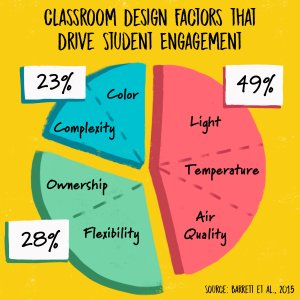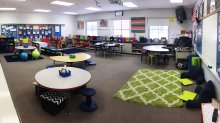Flexible Classrooms: Research Is Scarce, But Promising
An ambitious study of 153 classrooms in the United Kingdom provides the best evidence that flexible spaces can boost academic performance.
Your content has been saved!
Go to My Saved Content.There are plenty of studies that isolate the effects of light, acoustics, or air quality on learning. But the research on flexible classrooms is frustratingly scarce.
There are good reasons for the apparent lack of interest. Variables like natural light and acoustics lend themselves to single-factor experiments that can be conducted in a laboratory setting. Give subjects a task to complete in a room with ample windows, for example, and then administer the same test in a room without them.
But flexible classrooms are complex, living systems. One flexible space looks nothing like the next, and often dozens of children and one or more teachers operate within them, pushing and pulling furniture into novel configurations, dimming or turning up lights, and otherwise reshuffling things to suit an almost infinite variety of personal preferences. Studying flexible classrooms, it would seem, means circulating among real children.
Despite the challenges, an ambitious effort to study the design of lived-in classrooms, including looking at hard-to-define factors like flexibility, was completed in 2015 by the University of Salford, in the United Kingdom. Researchers put in the legwork, visiting 153 classrooms in 27 schools across the country—from small, remote village schools to much larger suburban buildings on the outskirts of metropolitan London. In the end, the effect of classroom design on academic performance was studied across 3,766 British children aged 5 to 11.
“We were trying to take a holistic perspective,” explained Peter Barrett, the lead researcher and now an honorary research fellow at the University of Oxford. “In other words, we were trying to look at spaces as experienced by people. So this isn’t just air quality, this isn’t just temperature, or an effort to measure the factors separately. This is the whole lot together.”
The Findings
The study looked at three dimensions of classroom design: naturalness (factors like light and temperature), stimulation (factors like color and visual complexity), and individualization (factors like flexibility and student ownership).
The big insight? Optimizing all of these physical characteristics of primary classrooms improved academic performance in reading, writing, and mathematics by 16 percent. The personalization of classrooms—including flexibility, which Barrett defined as “student choice within the space”—accounted for a full quarter of that improvement.
Another way to look at it: When isolated from other measured factors, classroom flexibility is about as important as air quality, light, or temperature in boosting academic outcomes.

Barrett’s team singled out the effectiveness of learning zones—“a reading area, a wet area, usually a carpet area for whole-class activity, tables usually in blocks of four or six”—and made special note of unique classroom shapes, which seem to allow for easier partitioning of the space. But the study doesn’t prescribe fixed solutions, setting out loose guidelines instead. When I described American flexible classrooms, which are even more individualized than their British counterparts, Barrett agreed that the Salford findings applied.
A few insights surprised even the researchers. Flexible, welcoming spaces had a startlingly large effect on learning in math—73 percent of the students’ progress that was attributed to classroom design was traced back to flexibility and student ownership. The reasons are a mystery, but Barrett and his team hazarded a guess: Academic subjects that provoke anxiety—in math, that’s a known issue—are better addressed in classrooms that feel comfortable and familiar to students.
And some of the air quality data came as a shock. Despite a 2015 Harvard study that showed steady declines in higher-order thinking when carbon dioxide levels exceed 500 parts per million—the gas is a by-product of human breathing, for those who’ve forgotten their biology—the researchers consistently recorded levels over six times that high in a classroom they observed. That’s alarming—and fixable.
“If air quality is OK at the start of the class, it won’t be by the end unless you do something,” according to Barrett. “It’s an absolute fact. So you have to open a window or a door. But you have to do something.”
Form, Function, and Flexibility
So will lugging new furniture into your room improve student outcomes? Do Hokki stools and throw pillows drive up test scores?
The answer is no.
Barrett thinks it’s the old dictum that form follows function at work: Flexible classrooms are successful because they go hand in hand with a change in pedagogy. That conclusion never fails to emerge in teacher-led discussions on Edutopia. Flexible spaces, educators agree, alter the fundamental dynamics of teaching and learning, giving students more control and responsibility, improving academic engagement, and undermining the typical face-forward orientation of the traditional learning environment.
In other words, it’s not the inert fact of the furniture itself—the new couch in the center of the room or the standing desk near the window—but the dynamic use of the space by the teacher and students that pays, in the end. Changing the layout of your classroom will almost certainly have no impact at all—if you don’t change your teaching too.
The takeaway: Flexibility, combined with characteristics like acoustics and air quality, has a real impact on student achievement. If used properly, flexible classrooms produce better academic outcomes among primary school children than more traditional, static classroom designs.
The author of this article is the chief content officer at Edutopia. You can follow him on Twitter @smerrill777.
